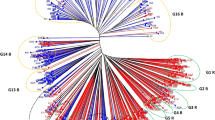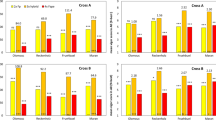Abstract
Capturing heterosis for dry matter yield in forage crops needs to consider both the final product of the breeding process (the type of cultivar) and the breeding method used to produce the cultivar. The discussion is focused specifically on alfalfa and on the semi-hybrid variety model allowing partial expression of heterosis with the technology currently in use and no drawbacks to seed production. The search for heterotic groups is a key point to improve the process of semi-hybrid construction. Among-subspecies diversity (i.e., Medicago sativa subsp. sativa and falcata) and selfing within subspecies are reviewed as tools to manage genetic diversity and to test the value of gene and linkat interactions in crosses. Different breeding methods have been proposed to produce semi-hybrid varieties. Experimental results on heterosis expression and yield gain of semi-hybrids vs the corresponding synthetic variety or elite cultivar are discussed in pointing out the basis of heterotic performance and in defining what are the key points in method and selection procedures to effectively exploit heterosis.
Access this chapter
Tax calculation will be finalised at checkout
Purchases are for personal use only
Similar content being viewed by others
References
Barnes, D.K., Bingham, E.T., Murphy, R.P., Hunt, O.J., Beard, D.F., Skrdla, W.H., Teuber, L.R. 1977. Alfalfa germplasm in the United States: genetic vulnerability, use, improvement, and maintenance. Tech. Bull. 1571. USDA-ARS, U.S. Gov. Print. Office, Washington, DC.
Bingham, E.T., Groose, R.W., Woodfield, D.R., Kidwell, K.K. 1994. Complementary gene interactions in alfalfa are greater in autotetraploids than diploids. Crop Sci. 34:823–829.
Brummer, E.C. 1999. Capturing heterosis in forage crop cultivar development. Crop Sci. 39:943–954.
Carelli, M., Gnocchi, G., Scotti, C. 2009. Alfalfa germplasm from a Sahara oasis: characterization by means of bio-agronomic traits and SSR markers. Plant Breed. 128:271–277.
Casler, M.D., Brummer, E.C. 2008. Theoretical expected genetic gains for among-and-within-family selection methods in perennial forage crops. Crop Sci. 48:890–902.
Flajoulot, S., Ronfort, J., Baudouin, P., Barre, P., Huguet, T., Huyghe, C., Julier, B. 2005. Genetic diversity among alfalfa (Medicago sativa) cultivars coming from a breeding program, using SSR markers. Theor. Appl. Genet. 111:1420–1429.
Holland, J.B., Bingham, E.T. 1994. Genetic improvement for yield and fertility of alfalfa cultivars representing different eras of breeding. Crop Sci. 34:953–957.
Kidwell, K.K., Hartweck, L.M., Yandell, B.S., Crump, P.M., Brummer, J.E., Moutray, J., Osborn, T. C. 1999. Forage yields of alfalfa populations derived from parents selected on the basis of molecular marker diversity. Crop Sci. 39:223–227.
Li, X., Brummer, E.C. 2009. Inbreeding depression for fertility and biomass in advanced generations of inter and intrasubspecific hybrids of tetraploid alfalfa. Crop Sci. 49:13–19.
Maureira, I.J., Ortega, F., Campos, H., Osborn, T.C. 2004. Population structure and combining ability of diverse Medicago sativa germplasms. Theor. Appl. Genet. 109:775–782.
Muller, M.H., Poncet, C., Prosperi, J.M., Santoni, S., Ronfort, J. 2005. Domestication history in the Medicago sativa species complex: inferences from nuclear sequence polymorphism. Mol. Ecol. 15:1589–1602.
Pedersen, M.W., Stucker, R.E. 1969. Evidence of cytoplasmic male sterility in alfalfa. Crop Sci. 9:767–770.
Riday, H., Brummer, E.C. 2002a. Forage yield heterosis in alfalfa. Crop Sci. 42:716–723.
Riday, H., Brummer, E.C. 2002b. Heterosis of agronomic traits in alfalfa. Crop Sci. 42:1081–1087.
Riday, H., Brummer, E.C. 2005. Heterosis in a broad range of alfalfa germplasm. Crop Sci. 45:8–17.
Riday, H., Brummer, E.C., Austin Campbell, T., Luth, D., Cazcarro, P.M. 2003. Comparison of genetic and morphological distance with heterosis between Medicago sativa subsp. sativa and subsp. falcata. Euphytica 131:37–45.
Rotili, P. 1976. Performance of diallel crosses and second generation synthetics of alfalfa derived from partly inbred parents. I. Forage yield. Crop Sci. 16:247–251.
Rotili, P., Busbice, T.H., Demarly, Y. 1996. Breeding and variety constitution in alfalfa: present and future. In: Parente, G., Frame, J., Orsi, S. (eds.),Grassland and Land Use Systems, 16th EGF Meeting (pp. 163–180). EGF & ERSA, Gorizia, Italy.
Rotili, P., Gnocchi, G., Scotti, C., Zannone, L. 1999a. Some Aspects of Breeding Methodology in Alfalfa. http://www.naaic.org/TAG/TAGpapers/rotili/rotili.html.
Rotili, P., Scotti, C., Kertikova, D., Gnocchi, S., Gnocchi, G. 1999b. Performance of diallel crosses of alfalfa derived from partly inbred parents with different levels of genetic diversity. II. Dry matter yield. In: Veronesi, F., Rosellini, D. (eds.), Proc. XIII Eucarpia Medicago spp. Group Meeting (pp. 338–342). University of Perugia, Italy.
Şakiroğlu, M., Brummer, E.C. 2007. Little heterosis between alfalfa populations derived from the Midwestern and Southwestern United States. Crop Sci. 47:2364–2371.
Segovia-Lerma, A., Cantrell, R.G., Conway, J.M., Ray, I.M. 2003. AFLP-based assessment of genetic diversity among nine alfalfa germplasms using bulk DNA templates. Genome 46:51–58.
Segovia-Lerma, A., Murray, L.W., Townsend, M.S., Ray, I.M. 2004. Population-based diallel analyses among nine historically recognized alfalfa germplasms. Theor. Appl. Genet. 109:1568–1575.
Staszewski, S. 1979. Cytoplasmic Male-Sterility and Heterosis in Alfalfa. Final Technical Report, Plant Breeding and Acclimatization Institute, Radzikov, Poland.
Author information
Authors and Affiliations
Corresponding author
Editor information
Editors and Affiliations
Rights and permissions
Copyright information
© 2010 Springer Science+Business Media B.V.
About this paper
Cite this paper
Scotti, C., Brummer, E.C. (2010). Creation of Heterotic Groups and Hybrid Varieties. In: Huyghe, C. (eds) Sustainable use of Genetic Diversity in Forage and Turf Breeding. Springer, Dordrecht. https://doi.org/10.1007/978-90-481-8706-5_75
Download citation
DOI: https://doi.org/10.1007/978-90-481-8706-5_75
Published:
Publisher Name: Springer, Dordrecht
Print ISBN: 978-90-481-8705-8
Online ISBN: 978-90-481-8706-5
eBook Packages: Biomedical and Life SciencesBiomedical and Life Sciences (R0)




